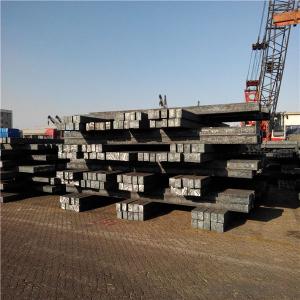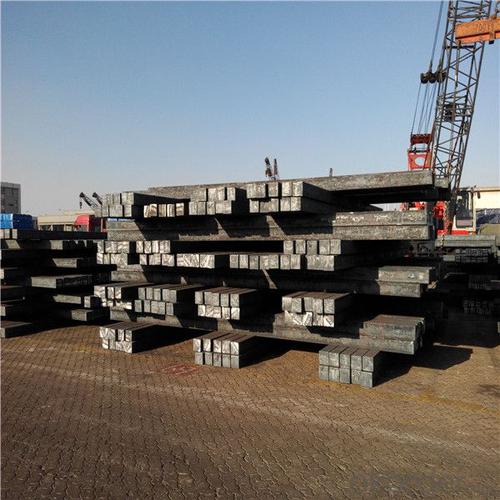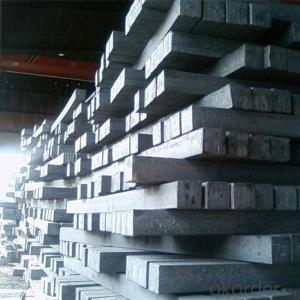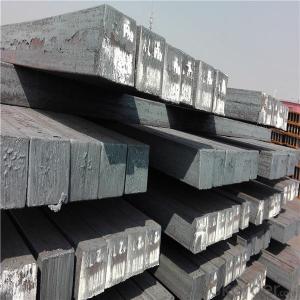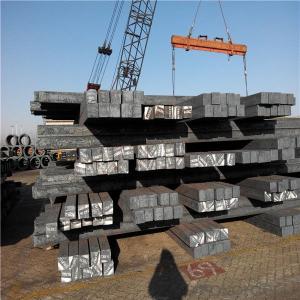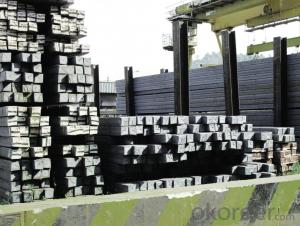Prime square steel billet best price from China
- Loading Port:
- Dalian
- Payment Terms:
- TT OR LC
- Min Order Qty:
- 1000 m.t.
- Supply Capability:
- 14721 m.t./month
OKorder Service Pledge
OKorder Financial Service
You Might Also Like
Specification
Rectangular billet continuous casting billet and mainly general carbon steel, low carbon low silicon cold-rolled material, high quality carbon structural steel, high strength low alloy steel, special steel, etc.
Steel billets have distinct characteristics as compared with already furnished steel bars and products.
Billets have a specific grain structure, which enables the metal to be processed more intricately. Steel billets
are also known for their malleability and ductility, especially when exposed to varying temperatures during
shaping and molding.
Gade:
Standard | C(%) | Mn(%) | S(%) | P(%) | Si(%) |
Q195 | ≤0.12 | ≤0.50 | ≤0.040 | ≤0.035 | ≤0.30 |
Q235 | ≤0.20 | ≤1.40 | ≤0.045 | ≤0.045 | ≤0.35 |
Q275 | ≤0.22 | ≤1.50 | ≤0.045 | ≤0.045 | ≤0.35 |
20MnSi | 0.17-0.25 | 1.2-1.6 | ≤ 0.050 | ≤ 0.050 | 0.40-0.80 |
3SP | 0.14-0.22 | 0.40-0.85 | ≤ 0.050 | ≤ 0.040 | 0.05-0.15 |
5SP | 0.28-0.37 | 0.50-1.00 | ≤ 0.050 | ≤ 0.040 | 0.15-0.30 |
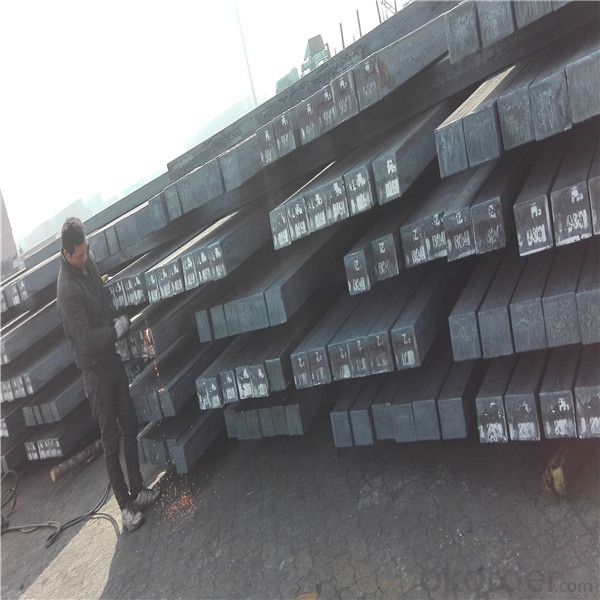
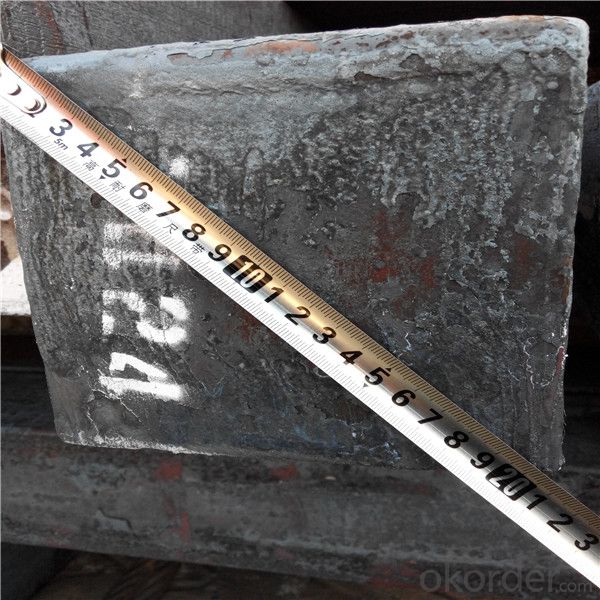


Other Specifications
Squar Tolerance: ±4
Length Tolerance: +100mm
Romboidity/Difference Diagonals: no more than 0.7%
Camber: no more than 1.5%(%)
Twist: no more than 3 degrees per 1 meter length
Our Advantage
* Professional Personnel of Steel Trading
* Strong Steel Industry Background
* Conveniently Geographic Location
Our Commitment
* Sincere, Practical, Efficient and Developing
* High Quality Steel Production
* Competitive Price and Timely Delivery
Packing :
Within 30 days
1.Standard export package
2.In bundles with steel strips
3.As the requirements of the customers
FAQ:
Q: How to get quotation?
A: When we receive your detailed enquiry, we will set the best price based on standard,
steel grade, outer diameter, wall thickness, quantity, country.
And we will send quotation to your mailbox.
Q:How to guarantee the quality of the products?
A:We have established the international advanced quality management system,every link from raw material
to final product we have strict quality test;We resolutely put an end to unqualified products flowing into the market.
At the same time, we will provide necessary follow-up service assurance.
Q:How long can we receive the product after purchase?
A :In the purchase of product within three working days, We will arrange the factory delivery as soon as possible.
The pecific time of receiving is related to the state and position of customers.
- Q: How are steel billets used in the manufacturing of industrial machinery?
- Steel billets are an essential component in the manufacturing of industrial machinery. These billets are semi-finished products that are produced through a process called continuous casting, where molten steel is poured into a mold to form a solid rectangular shape. Once the steel billets are formed, they undergo various processes to transform them into different components of industrial machinery. One common use of steel billets is in the production of machine parts such as gears, shafts, and axles. These components require high strength and durability to withstand the rigorous demands of industrial applications, and steel billets provide the necessary material properties. Steel billets are also used in the manufacturing of large structural components such as frames, bases, and supports for industrial machinery. These components need to be able to handle heavy loads and provide stability, and the use of steel billets ensures the necessary strength and rigidity. Furthermore, steel billets serve as raw material for forging, where they are heated and shaped using mechanical force to create complex shapes like crankshafts and connecting rods. The high malleability and ductility of steel billets make them ideal for forging, allowing manufacturers to produce intricate and precise components for industrial machinery. In addition, steel billets are often used in the production of specialized machinery, such as rolling mills and presses, which are used in various industrial processes. These machines require robust components that can withstand high temperatures, pressures, and forces, and steel billets provide the necessary strength and resilience. Overall, steel billets play a vital role in the manufacturing of industrial machinery as they provide the necessary strength, durability, and versatility required for producing various components and structures. Their use ensures the reliability and performance of industrial machinery in a wide range of applications.
- Q: How are steel billets used in the manufacturing of telecommunications equipment?
- Steel billets are an essential component in the manufacturing of telecommunications equipment. These billets serve as the raw material that is shaped and transformed into various components used in telecommunications infrastructure. One of the primary uses of steel billets in telecommunications equipment manufacturing is in the production of towers and masts. These structures provide the necessary support for antennas and other equipment used in transmitting and receiving signals. Steel billets are melted and then forged or rolled into the desired shape to form the structural members of these towers, ensuring their strength and stability. Additionally, steel billets are also used in the manufacturing of cable trays and cable management systems. These components are crucial for organizing and protecting the vast network of cables that are used in telecommunications systems. Steel billets are processed and fabricated into cable trays, brackets, and supports, providing a sturdy and durable solution for managing the complex web of cables. Furthermore, steel billets find application in the production of enclosures and cabinets used to house sensitive telecommunications equipment. These enclosures provide protection from environmental factors such as dust, moisture, and temperature fluctuations. Steel billets are molded and shaped into the desired size and design, ensuring a robust and secure enclosure for the equipment. In summary, steel billets play a vital role in the manufacturing of telecommunications equipment. From towers and masts to cable trays and enclosures, these billets provide the foundation and structural integrity necessary for the reliable operation of telecommunications infrastructure.
- Q: How do steel billets contribute to the construction of bridges and infrastructure?
- Steel billets play a crucial role in the construction of bridges and infrastructure due to their strength, versatility, and durability. These cylindrical bars of steel are produced through a process called casting, where molten steel is poured into molds and allowed to cool and solidify. One of the primary contributions of steel billets to bridge construction is their high load-bearing capacity. Bridges are subjected to heavy loads, such as the weight of vehicles, pedestrians, and even natural forces like wind and earthquakes. Steel billets, with their exceptional strength and structural integrity, provide the necessary support to withstand these loads and ensure the safety and stability of the bridge. Furthermore, steel billets offer flexibility in design and construction. Their malleability allows them to be easily shaped and formed into various structural components, such as beams, columns, and girders, which are essential elements in bridge construction. This flexibility enables engineers to create innovative designs and optimize the use of materials, resulting in cost-effective and efficient bridge structures. Another significant advantage of steel billets is their resistance to corrosion. Bridges are constantly exposed to harsh environmental conditions, including moisture, saltwater, and pollution. Steel billets can be treated with protective coatings or alloyed with elements such as chromium or nickel to enhance their resistance to corrosion. This ensures the longevity and durability of the bridge, reducing maintenance costs and enhancing its lifespan. Additionally, steel billets contribute to the speed of bridge construction. As these billets are prefabricated in steel mills, they can be produced in large quantities and transported to the construction site, ready for assembly. This prefabrication process reduces the time required for on-site construction, minimizing disruption to traffic and reducing overall project duration. In summary, steel billets are integral to the construction of bridges and infrastructure due to their high load-bearing capacity, flexibility in design and construction, resistance to corrosion, and contribution to faster construction times. Their contribution ensures the safety, longevity, and efficiency of bridge structures, making them an essential component in the development of robust and reliable infrastructure systems.
- Q: What is the typical composition of steel billets?
- The composition of steel billets can vary depending on specific requirements and intended use, resulting in a typical composition that primarily consists of iron and carbon. Other elements are added to enhance certain properties. The carbon content in steel billets typically ranges from 0.1% to 0.3%. Besides iron and carbon, steel billets often contain small amounts of manganese, silicon, sulfur, and phosphorus. Manganese improves strength, hardness, and heat treatment response. Silicon is commonly added to enhance fluidity during casting. Sulfur and phosphorus are impurities that need to be minimized as they can adversely affect machinability and mechanical properties. Additionally, steel billets may contain alloying elements like chromium, nickel, molybdenum, and vanadium to impart specific properties. Chromium improves corrosion resistance, nickel enhances toughness and ductility, molybdenum increases high-temperature strength, and vanadium improves wear resistance. In summary, the composition of steel billets is carefully controlled to achieve desired mechanical, physical, and chemical properties required for subsequent processing and final applications of the steel.
- Q: How are steel billets stored and transported?
- Steel billets, which are used for further processing, are carefully stored and transported to maintain their quality and safety. In terms of storage, steel billets are kept in designated areas within steel plants or warehouses, equipped with proper ventilation, drainage, and protection from the elements. They are organized in stacks with enough space between them for easy accessibility and inspection. To maximize space, steel billets are often stored vertically in racks or on specially designed shelves. This allows for easy handling and transportation. When it comes to transportation, heavy-duty equipment such as cranes or forklifts are used to move the billets safely, minimizing the risk of damage or injury. Chains or straps are used to secure the billets and prevent movement during transit. For longer distance transportation, steel billets are loaded onto trucks, trains, or ships. Containers or trailers are chosen based on the size and weight of the billets to ensure stability and safety. Proper weight distribution is crucial to maintain balance and prevent accidents. During transportation, it is important to protect the billets from moisture, extreme temperatures, and other external factors that could affect their quality. This may involve covering them with tarpaulins or using specialized containers. In conclusion, steel billets are stored and transported with great care to maintain their integrity and quality. Proper storage methods and suitable environmental conditions prevent damage and deterioration. Heavy-duty equipment and secure transportation minimize the risk of accidents. By following these practices, steel billets can be safely stored and transported, ready for further processing in the steel industry.
- Q: How are steel billets stored?
- Steel billets are typically stored in a controlled environment to protect them from corrosion and other damages. The storage method varies depending on the size and quantity of the billets, as well as the specific needs of the steel manufacturer. One common method of storing steel billets is to stack them horizontally on a flat surface. This can be done on a concrete floor or on steel racks designed for this purpose. The billets are usually placed in rows and columns, with enough space between them to allow for easy access and inspection. In order to prevent corrosion, the billets are often coated with a protective layer, such as oil or rust inhibitors, before being stored. Additionally, the storage area may be equipped with dehumidifiers or climate control systems to maintain ideal humidity levels and prevent moisture from damaging the steel. For larger quantities of billets, they may be stored vertically in specialized racks or bins. This allows for better space utilization and easier handling with the help of machinery like cranes and forklifts. These vertical storage systems are designed to ensure that the weight of the billets is evenly distributed to prevent any deformation or damage. Regardless of the storage method used, it is crucial to regularly inspect the billets for any signs of damage or deterioration. This includes checking for rust, cracks, or any other defects that may affect the quality of the steel. Proper documentation and inventory management are also important to ensure efficient retrieval and usage of the billets. Overall, steel billets are stored in a manner that prioritizes their protection and preservation. By following appropriate storage practices, steel manufacturers can maintain the quality of the billets and ensure their suitability for subsequent manufacturing processes.
- Q: How are steel billets reheated before rolling or forging?
- Steel billets are reheated before rolling or forging through a process known as billet heating. This process involves subjecting the billets to high temperatures to make them more malleable and easier to shape. There are several methods commonly used for billet heating, including: 1. Furnaces: The most common method of reheating steel billets is through the use of furnaces. These furnaces are typically gas-fired and can reach temperatures of up to 1,200 degrees Celsius. The billets are loaded into the furnace and heated for a specific period of time to achieve the desired temperature. The furnace provides a controlled environment, allowing for even heating and uniformity. 2. Induction heating: Another method used for reheating steel billets is induction heating. This process utilizes electromagnetic induction to heat the billets. An alternating current is passed through a copper coil, creating a magnetic field. The billets are then placed inside the coil, and the magnetic field induces eddy currents within the billets, generating heat. Induction heating offers precise temperature control and rapid heating rates, making it suitable for high-speed production. 3. Electric resistance heating: Electric resistance heating is another technique employed for reheating steel billets. This method involves passing an electric current through the billets, causing them to heat up due to the resistance encountered. Electric resistance heating can be achieved using various types of heating elements, such as graphite electrodes or resistance heating wires. This method offers precise temperature control and is commonly used for smaller-scale operations. Regardless of the heating method used, it is essential to carefully control the temperature and heating time to ensure the billets reach the optimal temperature for rolling or forging. The reheating process allows the steel to become more pliable, reducing its hardness and increasing its ductility, making it easier to shape and form into the desired end product.
- Q: What are the different types of steel billet forming processes?
- The different types of steel billet forming processes include hot rolling, cold rolling, extrusion, forging, and casting.
- Q: How are steel billets cooled after the manufacturing process?
- Steel billets are typically cooled after the manufacturing process using methods such as air cooling, water quenching, or accelerated cooling techniques.
- Q: How are steel billets used in the production of flanges?
- Steel billets are used in the production of flanges by being heated and molded into the desired shape and size. The billets are typically forged, rolled, or machined to form the flange, which is then used to connect pipes or valves in various industrial applications.
Send your message to us
Prime square steel billet best price from China
- Loading Port:
- Dalian
- Payment Terms:
- TT OR LC
- Min Order Qty:
- 1000 m.t.
- Supply Capability:
- 14721 m.t./month
OKorder Service Pledge
OKorder Financial Service
Similar products
Hot products
Hot Searches
Related keywords
